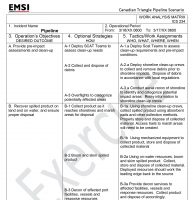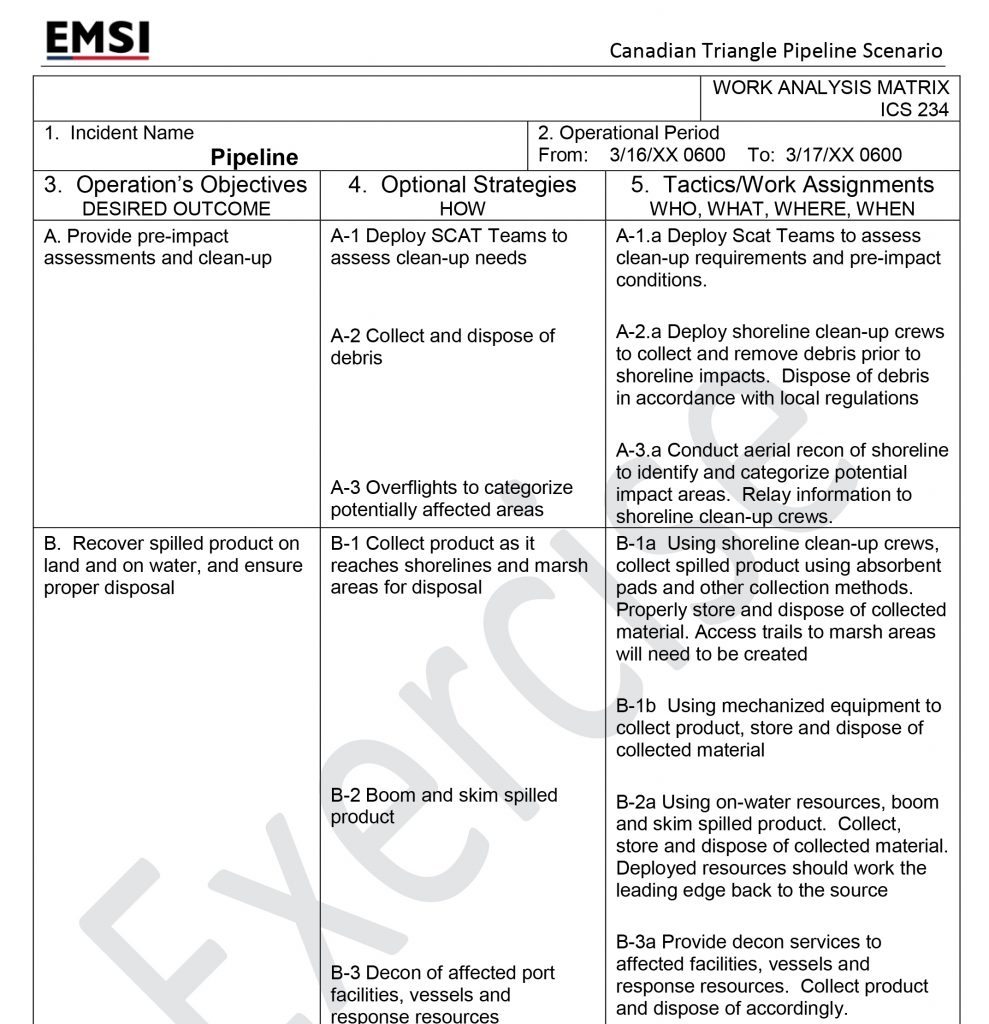A well-known and important tool, the Operational Planning Worksheet (ICS-215) is used by the Operations Section Chief in preparing for the next Operational Period; a less well known, but equally important tool, is the Work Analysis Matrix (ICS-234). Looking at an ICS Operational Planning “P”, your work on the ICS-215 starts during the period of time called Preparing for the Tactics Meeting. The ICS-215 is used to outline work assignments and resource requirements for the next Operational Period. During the Tactics Meeting, the ICS-215 gets a thorough review by the Safety Officer, Planning Section Chief (and Resources Unit Leader), and Logistics Section Chief; others may also review it, but these are the primary players. The form is then cleaned up and presented to Command and the rest of the Command & General Staff at the Planning Meeting before being used to generate Assignment Lists (ICS-204s) for the Incident Action Plan.
But what is the ICS-234 and how does it relate to the process described above?
The ICS-234 is an important, yet simple tool available for Operations Section Chiefs to outline strategies and tactics to accomplish Command’s operational objectives. For almost every objective established by Command, there are numerous strategies that can be implemented to accomplish the objective. The ICS-234 allows the Operations Section Chief to consider and document these various strategies and then select the most appropriate one. The ICS-234 is completed prior to beginning the ICS-215 to brainstorm and generate potential solutions. This allows the Operations Section Chief to consider specific work assignments and resources to accomplish the chosen strategies and tactics.
The ICS-234 is a simple three column worksheet. The left hand column is where each of the Command’s objectives is written, the middle column is where the various strategies to accomplish the objective are outlined, and the right hand column is where the specific tactics required to accomplish each strategy are detailed. After completing the ICS-234, the Operations Section Chief has a complete list of the available strategies and tactics to accomplish Command’s objectives and can now select the most appropriate course of action.
In order to put everyone on the same page, we will use the following definitions for objective, strategy, and tactic.
An objective is defined as: Statements of direction from Command that guide efforts or actions to achieve the desired outcome. Objectives clearly describe the outcomes that the response organization is working to achieve. They are necessary for the selection of management actions to address the problem or for the selection of operational strategies and tactical direction of resources
A strategy is defined as: The general operational direction that describes “how” to accomplish an objective. Strategies are usually higher level and identify how the objectives is going to be accomplished, without getting into the detailed tactics.
A tactic is defined as: The specific details of implementing and accomplishing a Strategy including the “who”, “what”, “when”, and “where”. Tactics include the detailed operational procedures and techniques carried out by specifically assigned resources within either geographically or functionally oriented elements of the Operations Section.
Why is the ICS-234 not as commonly used as the ICS-215?
The ICS-215 is one of the original forms of the Incident Command System and has been used in the IAP development process since the beginning of ICS. The ICS-234 is a relatively new form that has only been around for about 10 years and is more common in all-hazards incident management. While the form is new, the process it facilitates is not. All Operations Section Chiefs (at least the good ones!), consider the different strategies that can be implemented to meet Command’s objectives. This thought process is typically conducted sometime between the Command & General Staff Meeting and beginning work on the ICS-215. The ICS-234 is a tool to help facilitate and document this process.
Most wildland fire Operations Section Chiefs will tell you that their thought process is simple because there are limited strategies to fight wildland fire (direct or indirect). While this may be an over simplification and is open to debate, there is no question that in the all-hazards incident management environment there can be numerous strategies to accomplish an objective and the ICS-234 is a valuable tool for the Operations Section Chief to document these various strategies, as well as their thought processes.
So why should an Operations Section Chief use the ICS-234?
Many of you may be familiar with the acronym PACE. PACE, which stands for Primary, Alternate, Contingency, and Emergency, was originally used to develop military communications plans but has broader application when discussing operational planning. When considering strategies and developing a course of action, any good planner considers PACE. The ICS-234 is an outstanding tool to facilitate the PACE process. What are the primary and alternative (there may be more than one alternative) strategies? What if something goes wrong and we need a contingency strategy? What if something catastrophic occurs and we need an emergency strategy? All of these strategies and more can be captured on the ICS-234. If an Operations Section Chief develops strategies to meet the intent of PACE, they have likely done their due diligence in thinking through how to accomplish the objective and considering various strategies and courses of action.
P.A.C.E.
Primary
Alternate
Contingency
Emergency
So far we’ve spent most of our time talking about the strategy piece of the ICS-234. But what about the tactics piece in the right hand column? Well, once the strategies are identified, the Operations Section Chief documents the specific and detailed tactics that can be implemented to accomplish the strategy. If the strategy is more generally “how” the objective is going to be accomplish, the tactics fill in the details of how the strategy will be implemented and may include “who”, “what”, “when”, and “where”. Much like there can be multiple strategies to accomplish an objective, there may also be multiple tactics to accomplish a strategy. It should be noted that “who” does not refer to the specific resource by name, but more generally the kind and type, or the general capability.
By completing the ICS-234 and presenting it to Command, the Operations Section Chief demonstrates that they were thoughtful and mindful in their consideration and selection of strategies and tactics, and if the chosen strategy and tactic doesn’t work for some reason, the Operations Section Chief has other strategies and tactics to fall back on. A complete ICS-234 should give an Incident Commander a sense of confidence that their Operations Section Chief is on top of his game.
When preparing the IAP, the ICS-234 can be a source of information for completing work assignments on the ICS-204s. If the ICS-234 is thorough and detailed, the tactics in the right hand column can be used to form the basis for the tactical portion of the individual work assignments on the ICS-204s.
Who else might get involved in completing or reviewing the ICS-234?
Much of the focus of in this article has been on the role of the Operations Section Chief in completing the ICS-234, but others may have a hand in this.
Planning Section Chief: The Planning Section Chief may have access to contingency plans that have already identified potential strategies. This is especially common in oil and hazardous materials response where there are well developed contingency plans that include this type of information, such as booming strategies and dispersant strategies. The Planning Section Chief may also use information from the Resources Unit, Situation Unit, or Environmental Unit when reviewing or assisting the Operations Section Chief with the ICS-234:
- Resources Unit: The availability of resources may influence the strategies and tactics chosen.
- Situation Unit: An evolving situation and incident environment, including weather, may influence the strategies and tactics chosen.
- Environmental Unit: Environmental considerations and impacts, as well as sensitive areas, may influence the strategies and tactics chosen.
Logistics Section Chief: The Logistics Section Chief may determine that a particular strategy requires logistical support above and beyond what the Logistics Section can reasonably provide or that one particular strategy can reasonably accomplish the same objective but is less logistically intensive. If the Logistics Section cannot support a strategy, that strategy is not implementable and the Logistics Section Chief needs to weigh in on this.
Safety Officer: The Safety Officer plays a significant role in this process and needs to assess whether the strategies can be implemented safely. They need to assess the hazards and risks, both to responders and the public, a particular strategy pose, and if the risk is too great, the strategy may not be feasible. The Safety Officer may determine that the objective can be accomplished with a strategy that is safer, but equally effective.
Technical Specialists: Technical Specialists may have extensive knowledge of the various strategies and tactics that can be implemented to accomplish an objective, providing a range of alternatives to the Operations Section Chief.
Finance Section Chief: If there are fiscal constraints, the Finance Section Chief may examine the strategies for cost factors. If one strategy accomplishes the same objective as another but is half the cost, the Finance Section Chief may encourage the Operations Section Chief to consider the less expensive option.
Public Information Officer: In some cases, the Public Information Officer may weigh in on how the proposed strategies may be perceived by the public and if one particular strategy will be more palatable to the public.
Liaison Officer: In some cases, the Liaison Officer may weigh in on how the proposed strategies are going to be received by stakeholders.
Command: While Command should not get involved in the process of completing the ICS-234, Command’s Direction, communicated during the Command & General Staff Meeting, must be considered by the Operations Section Chief when completing the ICS-234. In addition to Objectives, other elements of Command Direction including Priorities, Limitations and Constraints, and Decisions, may push the Operations Section Chief to choose one strategy or tactic over another.
Summary
The ICS-234 is a valuable tool available to the Operations Section Chief. If helps organize a thought process and allows the Operations Section Chief to consider and document a wide range of strategies and tactics to accomplish the objectives. The ICS-234 should be part of the process for Preparing for the Tactics Meeting, and should be a critical element of the Tactics Meeting and Planning Meeting. It is recommended that the ICS-234 be completed before starting the ICS-215 as the strategies and tactics selected may determine the work assignments and resources. Much like the ICS-215, the ICS-234 is a worksheet that is used to develop the IAP, but it is not included in the IAP. Information from the ICS-234 ends up in the IAP through the individual work assignments on the ICS-204s. If you’re not already using the ICS-234, it is recommended you try it during your next incident or exercise.
ICS forms, as well as training and job aids related to using ICS forms and more, can be found at www.EMSICS.com.




